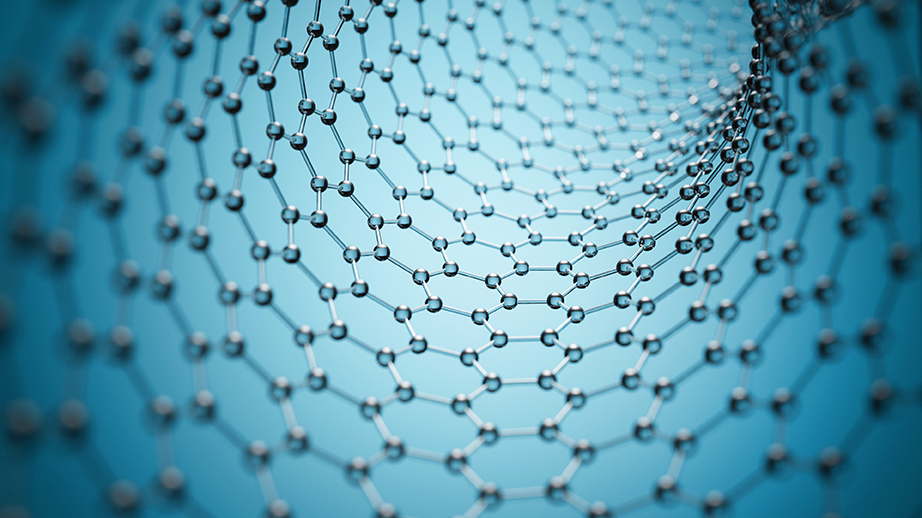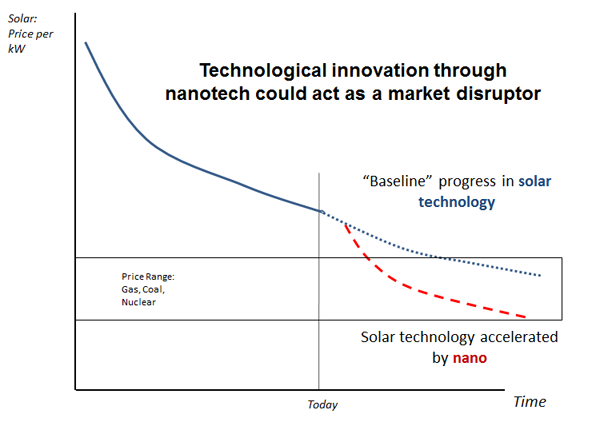When Energy Technology Goes on Steroids: The Nano-Energy Interface

PDF: When Energy Technology Goes on Steroids: The Nano-Energy Interface
On this page
Summary
Renewables
Electricity and Grids
Conventional Energy
Summary
In the not-so-distant future, nanotech is positioned to create significant change across several domains, especially in energy where it may bring large and possibly sudden performance gains to renewables and smart grids. On price per watt basis, innovative applications of nanotech have the potential to triple the output of solar, and double in the case of wind. Nanotech enhancements may also increase battery power by orders of magnitude, allowing intermittent sources such as solar and wind to provide a larger share of overall electricity supply without sacrificing stability. Nanotech sensors will also enable smart grids and foster more flexible and decentralized electricity management.
Emerging research suggests that there is great potential for disruptive change – thereby warranting further consideration of the implications for Canada’s electricity generation and distribution infrastructure, as well as for business opportunities in the global energy market.
Policy Horizons Canada is currently undertaking a foresight study on emerging technologies, with nanotechnology being one of the areas of focus. As a powerful enhancer of technology, nanotech can be seen as the “steroids” for certain technologies. Nanotech is positioned to create significant change across several domains, especially in energy where it may bring rapid efficiency gains in renewables, smart electricity grids and even reduce environmental effects of conventional energy sources.
What is nanotechnology? Nanotechnology is the engineering of functional systems at the molecular scale. Scientists and engineers are discovering a wide variety of ways to change materials at the nanoscale to take advantage of new and remarkable properties, such as higher strength, lighter weight, enhanced conductivity, and greater chemical reactivity than their larger-scale counterparts.
Renewables
Despite significant progress in recent years, most renewables cannot compete with conventional energy options since they offer less on a dollar-per-watt basis. Nanotech, however, may accelerate the technology behind renewables in various ways:
- Experts are discovering means to apply nanotech to photovoltaics, which would produce solar panels with double or triple the output by 2020. For example, nanostructured membranes consisting of a “sandwich” of metal and plastic can collect and trap significantly more light than previous methods. Nanotech will also enable much faster and cheaper manufacturing of photovoltaic cells by enabling the printing of receptors on thin rolls of aluminum.
- Wind turbines stand to improve from high-performance nano-materials like graphene, a nano-engineered one-atom thick layer of mineral graphite that is 100 times stronger than steel. Nanotechnology will enable light and stiff wind blades that spin at lower wind speeds than regular blades. Also, nanotech can lead to other benefits, such as lower operating and maintenance costs by protecting the turbine blades with nano-engineered hydrophobic coatings. These nano-coatings bond to the surface of the material, dramatically lowering the surface energy so that when droplets come into contact, they form beads and simply run off, resulting in less need for cleaning and de-icing. This would be a significant advantage, since maintenance can be costly as turbines are often spread out over remote areas.
- Nanotechnology could play a major role in the next generation of batteries. For example, coating the surface of an electrode with nanoparticles increases the surface area, thereby allowing more current to flow between the electrode and the chemicals inside the battery. Such techniques could increase the efficiency of electric and hybrid vehicles by significantly reducing the weight of the batteries. Moreover, superior batteries would complement renewables by storing energy economically, thus offsetting the whole issue of intermittent generation (variable sun and wind conditions). With over $155 million allocated over five years through the US Joint Center for Energy Storage Research to develop high performance low-cost batteries, developments in this area seem likely.
Solar (photovoltaic) is a good example of how nanotechnology can accelerate the progress of a technology. Graph 1.0 shows how solar is coming down in price, and how its ability to compete against traditional energy choices may happen even more quickly due to nanotech. Economic disruptions could therefore occur sooner than anticipated.
Figure 1: Technological innovation through nanotech could act as a market disruptor

This images shows a graph depicting how “Technological innovation through nanotech could act as a market disruptor” with time on the x-axis and price per kW on the y-axis (solar).
Electricity and Grids
In a somewhat more distant future, we may see electricity systems apply nanotechnology in transmission lines. Electricity transmission can experience losses due to resistance of approximately 1% over 160 km (AEP, 2013). This means that power generated in remote regions of provinces can diminish by as much as 17% (HydroOne, 2013) by the time it reaches urban areas. Research indicates that it is possible to develop electrical wires using carbon nanotubes that can carry higher loads and transmit without power losses even over hundreds of kilometres. The implications are significant, as it would increase the efficiency of generating power where the source is easiest to harness. In concept, this would enable transmitting geothermal power from Alberta or wind power from the North across multiple provinces.
Nanotech could potentially transform how we use electricity through smart grids. Smart grids operate using a two-way flow of electricity and information, to enable the quick re-allocations of supply to match demand. To build this, sensors are needed. Smart grids could be realized by incorporating nanosensors throughout the grid at various points, such as at transformers or even in appliances. According to Dr. Pradeep Haldar, Vice President for Clean Energy Programs with the College of Nanoscale Science & Engineering at the University of Albany, “Without nanotechnology, you don’t have anything small enough, fast enough or cheap enough for the smart grid to fully evolve.”
Conventional Energy
Nanotech is also able to support conventional energy industries. Environmental effects of oil refining processes can be reduced at various stages of development:
- Manufacturers of nanocrystalline celluose (NCC) have discovered special applications using NCC as an industrial lubricant for drilling and resource extraction. NCC is a by-product of pulp and paper, is entirely biodegrable, and can extend the life of expensive drilling equipment.
- Scientists are using advanced membranes involving nanotech to filter CO2, and current prototypes suggest the potential to cut carbon emissions by 25%.
Advances in nanotech are taking place all over the world. The examples mentioned above are only a small sample of the various applications related to the energy industry. There are equally fascinating developments in many other areas of nanotech.
These changes raise questions about the implications that emerging developments in nanotechnology may have for Canada’s economy, business investment strategies, and government policies. Is our energy industry and infrastructure sufficiently poised to take advantage of the innovations offered by nanotech? Do we have the necessary labour and skills expertise, and the right investment climate for technological uptake?